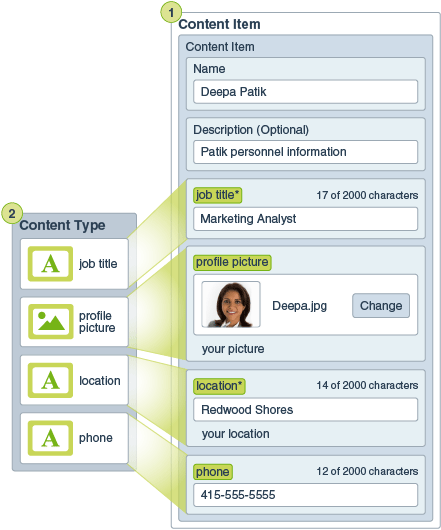Understand Structured Content
“Structured content” is a term used to describe content that exists separately from any file or layout.
Overview of Structured Content
A content type is a framework for information that can be used in a website or for other projects. You can think of a content type like a form, where information is entered and saved. The content type is used to create a content item. Content items are essentially individual instances of the completed content type "form".
A content type might require text, a date, an image, or a variety of numerical fields. It all depends on what’s needed. Because each piece of information is in a separate field, possibly even a separate referenced asset, you can reuse pieces of the content by referencing them in other assets. And, the content type may have several different associated layouts, so depending on where your content is used, it might appear with a large picture and small typeface, or a small picture with wraparound text.
For example, perhaps there’s a content type called Employee Information. It might have fields for a job title, geographical location, a brief biography, and a picture. When you use that content type to create a content item, you enter specific information: job title, location, contact information, and upload a photo as a separate digital asset that's referenced in the content item. The location and contact information may be omitted in one place or included in another, and the employee photo may be just a small avatar or a larger image next to the employee's bio. The content itself won’t change, but the layout and which pieces are displayed can change without affecting the actual content that you entered.

A content type is created by a user with the content administrator role, and then has to be associated with a repository. Enterprise users with at least the contributor role to the repository can then use the content type to create a new content item. Depending on your role in the organization, you may not actually put structured content to use. You may just create content items or add business documents that are needed. See Learn About User Roles for details about roles and responsibilities.
Use Structured Content
Here’s a broad overview of how structured content and digital assets can be created and used. In some organizations, one step may occur before or after another.
- Templates and layouts for a website and content types are designed and deployed. This is usually handled by an IT designer with content administrator or site administrator privileges. Often those roles are given to one person, but some organizations may have different people in those roles.
- Collections (1) are created to manage the website elements. When a site is created a collection is automatically created, making it easy to manage all the content for the site. Or users can create independent collections to manage their digital assets.
- A person with a content administrator role designs the content types (2).
- The content administrator must share the collection and associate the content types with a repository, then users with at least the contributor role on the repository can upload assets and create content items (3).
- Contributors add the content items and upload the digital assets (4) for the website or project. When a content item is created, it’s assigned to a collection so it can be managed with the collection’s policies.
- A content type can have different content layouts (5) associated with it, letting you display the content in different ways.
- The IT designer or site administrator adds the digital assets and content items to the website or the project. On a website, the items appear as part of the content available to use on the site.

Example
Remember that a content item is created using a content type as a guide. Most content types are tailored to fit a particular need in a website or other type of output. After content items are created, they’re available for use on a website if one is associated with the collection. Anyone with a contributor role for the website can add it to the site by selecting it and dragging it and dropping it to the website in any slot that accepts content.
When you create a content item, you can edit it later and not affect anything where the content item is used. For example, perhaps you need to write a short, daily update for your website. You or your administrator create a content type called News Article. The content type has fields for short text, a date, and a small paragraph.
You create the News Today content item using that content type and you add it to your website collection. Then you add the News Today content item to your website and preview how it looks. Once it looks the way you want, it can be published.
Then you can edit News Today every day and change the text included in the item and publish it. That changed text will be reflected on the website without any need for someone to update the website daily. The content changes independently of the website.